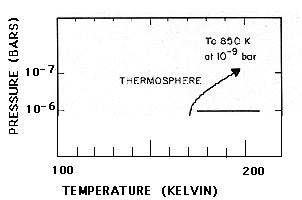This is a diagram showing the temperature profile.
Click on image for full size
Image from: Arizona Press
Jupiter's Thermosphere Temperature Profile
This is the temperature profile of Jupiter's thermosphere. The thermosphere is the other region of the atmosphere where warming takes place. On Jupiter, incoming particles from the magnetosphere play a strong role in raising the temperature of this region. The thermosphere is also warmed from the sun's ultraviolet radiation. There is no top, or thermopause, to the thermosphere.
The graph shows that the temperature goes from about 170 K (-153 degrees) to about 850 K (1100 degrees).
For a picture showing how the temperature changes in whole atmosphere, click here.
You might also be interested in:
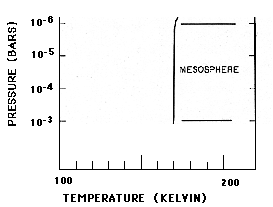
This is the temperature profile of Jupiter's mesosphere. The temperature is the same at all heights until the mesopause, or "top" of the mesosphere is reached. As shown in the figure, the mesopause is
...more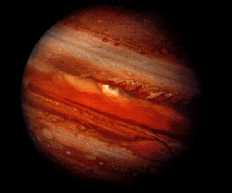
The giant planets have definitely changed since their formation. But how much remains to be seen. Most of the original air of the giant planets remains in place. (The earth-like planets lost most of their
...more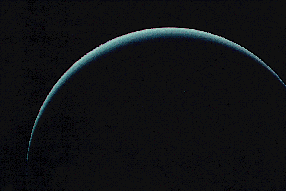
The mesosphere of Jupiter is a region of balance between warming and cooling. That essentially means that nothing happens there. Except for diffusion, the atmosphere is still. Upper reaches of the atmosphere,
...more
As on Earth, the atmosphere of Jupiter consists of a troposphere, stratosphere, mesosphere, and thermosphere. The troposphere is the region where the visible clouds are to be found. The stratosphere, as
...more
The stratosphere of Jupiter is a region of warming as determined by infrared measurements of methane (CH4) in the region. Like the troposphere, the stratosphere is warmed by the sun, warmed by Jupiter's
...more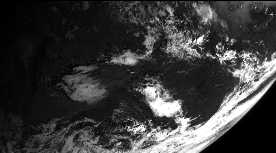
The troposphere of Jupiter is where the clouds are. Clouds form in regions of strong atmospheric motion, when condensation takes place. The troposphere is the region rapidly stirred by vertical motions.
...more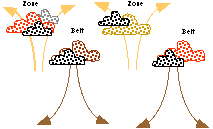
On Jupiter, the winds in the belts and zones blow first in one direction, then in the opposite direction. Wind blows east in a belt, and west in a zone. The clouds rise up in a belt, and drop down in a
...more


